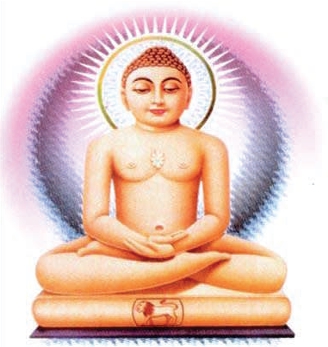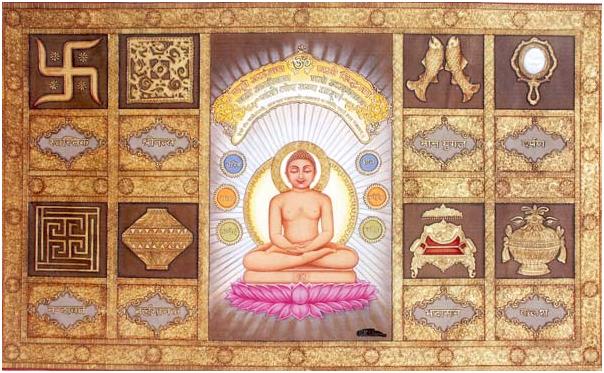
Tattvarthadhigama Sutra
Umāsvāmin or Umāsvāti is the author of the Tattvārthādhigama Sūtra or Tattvārtha Sūtra, the first Sanskrit work on Jaina philosophy. He lived in an early century of the Christian era. The Tattvārtha Sūtra is a manual for the understanding of the true nature of things. It is recognised as an authority by both the Śvetāmbaras and the Digambaras. It deals with Jaina logic, epistemology, psychology, ontology, ethics, cosmography and cosmology. It has a large number of commentaries, one being by the author himself.
Taraṅgavatī and Padmacarita
During the early centuries Pādalipta Sūri and Vimala Sūri wrote their excellent Prakrit works. The Taraṅgavatī, a religious novel, was composed by Pādalipta Sūri. It is mentioned in the Viśeṣāvaśyakabhāṣya of Jinabhadra, Kuvalayamālā of Dākṣiṇyacihna, Tilakamañjarī of Dhanapāla, etc.
The Padmacarita by Vimala Sūri is a Rāma-epic. It contains 118 cantos. Padma is the name of Rāma.
Karmaprakṛti and Pañcasaṅgraha
The Karmaprakṛti by Śivaśarman and the Pañcasaṅgraha by Candraṛṣi are two important Prakrit treatises on the Jaina doctrine of karma. They, too, were composed during the early centuries. Both of them have been commented upon by Malayagiri.
Siddhasena's Works
Siddhasena Divākara was a great logician. He also belonged to one of the early centuries. Like Umāsvāti, the author of the Tattvārtha Sūtra, he too, is regarded by both the sects as one of their own. His works include the Sanmatitarka, the Nyāyāvatāra and thirty-two Dvātriṁśikās (twenty-two are available). The Sanmatitarka is an excellent Prakrit treatise on the theory of Nayas (ways of approach and observation). It also deals with the theories of knowledge and judgment. The Nyāyāvatāra (Sanskrit) is the earliest Jaina work on pure logic. The Dvātriṁśikās (Sanskrit) are on different aspects of Jaina philosophy and religion. Siddhasena Divākara has really made a valuable contribution to Jaina philosophical literature.
Samantabhadra's Works
Samantabhadra's contribution to the philosophical literature of the Jainas is equally important. He is the author of the Āptamīmāṁsā, Yuktyanuśāsana and Svayambhūstotra. The Ratnakaraṇḍaka-śrāvakācāra is also ascribed to him by some scholars. In the Āptamīmāṁsā or Devāgamastotra the philosophy of non-absolutism is explained. The Yuktyanuśāsana is a hymn to Lord Mahāvīra in a philosophical theme. The Svayambhūstotra or Caturviṁśatijinastuti is a hymn to the twenty-four Jaina Tīrthaṅkaras. The Ratnakaraṇḍaka-śrāvakācāra is a manual of morals for the lay-votary. All these works are in Sanskrit. Samantabhadra was a Digambara preceptor who lived in an early century.
Devanandin's Jainendravyākaraṇa
Devanandin or Jinendrabuddhi, who is usually known by his honorific name Pūjyapāda, lived between the 5th and 6th centuries. He is famous as a grammarian. His celebrated work Jainendravyākaraṇa or Pañcādhyāyī is in two recensions. The longer one contains 3700 aphorisms, about 700 more than the shorter one. A commentary on the Tattvārtha Sūtra, entitled Sarvārthasiddhi, was also composed by Pūjyapāda. Some other works are also ascribed to him. He belonged to the Digambara sect.
Mallavādin's Nayacakra
The Nayacakra or Dvādaśāranayacakra by Mallavādin is an excellent Sanskrit work on the Jaina theory of Naya. The author is one of the great Śvetāmbara scholars of the early centuries. Tradition reports his decisive victory over the Buddhists. His commentary on Siddhasena Divākara's Sanmatitarka is not available. There exists a commentary on the Nayacakra, entitled Nyāyāgamānusāriṇī, by Siṁhasūri.
Akalaṅka's Works
Akalaṅka (7th century A.D.) was a great Digambara author and commentator. He composed the following philosophical (logical) treatises in Sanskrit:
He commented upon the Tattvārtha Sūtra and Āptamīmāṁsā. The commentary on the Tattvārtha Sūtra is known as Tattvārtharājavārttika and that on the Āptamīmāṁsā is called Aṣṭaśatī. A treatise on expiatory rites, entitled Prāyaścitta, is also ascribed to Akalaṅka. The authorship of this work is, however, doubtful.
Haribhadra's Works
Haribhadra (8th century), a famous Śvetāmbara writer, composed a large number of works both in Sanskrit and Prakrit. He was an eminent author in verse as well as in prose. His Ṣaḍdarśanasamuccaya (with Guṇaratna's commentary) is an important treatise on Indian philosophy. It gives a summary of the six philosophical systems of India. He wrote a commentary on the Nyāyapraveśa of Diṅnāga, a Buddhist logician. His Dharmabindu is a manual of morals. The Anekāntajayapatākā, Śāstravārttāsamuccaya, Anekāntavādapraveśa, Dvijavadanacapeṭā, Paralokasiddhi, Sarvajñasiddhi, Dharmasaṅgrahaṇī, Lokatattvanirṇaya etc., are his philosophical treatises. He composed the following works on yoga:
The Samarādityakathā, Dhūrtākhyāna, etc., are nice stories composed by him. He commented upon a number of canonical works and composed many miscellaneous treatises.

Kuvalayamālā
The Kuvalayamālā is a Prakrit poem composed by Uddyotanasūri (Dākṣiṇyacihnasūri) in 779 A.D. The author alludes to Pādalipta, Sātavāhana Ṣaṭparṇaka, Bāṇa, Vimalāṅka, Devagupta, Jaṭila, Prabhañjana, Raviṣeṇa and Bhavaviraha Haribhadra. There is another Kuvalayamālā in Sanskrit composed by Ratnaprabhasūri. It is based on the Uddyotanasūri's original in Prakrit. The author was assisted in this work by his grand-pupil Pradyumnasūri. Both the authors belonged to the Śvetāmbara sect.
Vidyānandin's Works
Vidyānandin or Vidyānanda (9th century) is a distinguished Jaina philosopher belonging to the Digambara sect. His Aṣṭasahasrī commentary on the Aṣṭaśatī (Akalaṅka's commentary on the Āptamīmāṁsā of Samantabhadra) is, perhaps, the most difficult of all the Jaina philosophical treatises. It was further commented upon by Yaśovijaya. Vidyānandin's Tattvārthaślokavārttika is an important commentary on the Tattvārtha Sūtra. His original philosophical works include the Āptaparīkṣā, the Pramāṇaparīkṣā, the Patraparīkṣā, the Satyaśāsanaparīkṣā and the Vidyānandamahodaya (extinct). The Yuktyanuśāsanālaṅkāra is his commentary on the Yuktyanuśāsana of Samantabhadra. He has also composed the hymn entitled Śrīpura-Pārśvanāthastotra. The Pañcaprakaraṇa is also ascribed to him. All his works are in Sanskrit.
Purāṇas
The Mahā-Purāṇa by Jinasena and Guṇabhadra (9th century) is the earliest of the Jaina Purāṇas. It contains the biographies of the 63 Great Men (24 Tīrthaṅkaras, 12 Cakravartins, 9 Baladevas, 9 Vāsudevas and 9 Prativāsudevas). It consists of two parts:
The Ādi-Purāṇa is divided into 47 chapters of which 42 are composed by Jinasena and the last 5 by his pupil Guṇabhadra. The Uttara-Purāṇa, which consists of 30 chapters, is exclusively from the pen of Guṇabhadra. The Ādi-Purāṇa contains the biographies of Ṛṣabha (the first Tīrthaṅkara) and Bharata (the first Cakravartin). The life-stories of the remaining Great Men are given in the Uttara-Purāṇa.
The Mahā-Purāṇa is an epic poem in Sanskrit. It claims to give a history of the world. Jinasena, the author of the Ādi-Purāṇa, is different from Jinasena, the author of the Harivaṁśa-Purāṇa.
There exists another Mahā-Purāṇa in the Apabhraṁśa language by Puṣpadanta. It is also divided into two parts:
The Ādi-Purāṇa by Puṣpadanta consists of 37 chapters and the Uttara-Purāṇa has 65 chapters. The work was completed in 965 A.D. The author also composed two other Apabhraṁśa works:
There is also a Mahā-Purāṇa by Malliṣeṇa. It was composed in 1047 A.D. It is in Sanskrit.
The works on the lives of the 63 Great Men, usually called 'Purāṇas', are by the Digambara authors. Similar works by the Śvetāmbara authors are called 'Caritras' or 'Caritas'.
Yaśastilaka and Nītivākyāmṛta
Somadeva, a Digambara author of the 10th century, is famous for his Yaśastilaka and Nītivākyāmṛta, both in Sanskrit The Yaśastilaka is a Campū (ornate novel in prose and verse) written after the model of Bāṇa's Kādambarī. Nītivākyāmṛta is a mixture of ethics and politics in short aphorisms. In the colophons of this work the author mentions the following works as his own:
Many famous poets, such as Bhāravi, Bhavabhūti, Bhartṛhari, Guṇāḍhya, Vyāsa, Bhāsa, Kālidāsa, Bāṇa, etc., are mentioned in the Yaśastilaka. The last three chapters of this work also form an independent book, called Upāsakādhyayana (Readings for Lay-votaries).
Nemicandra and His Works
Nemicandra, a Digambara author, lived between the 10th and 11th centuries. He was the teacher of Cāmuṇḍarāya who caused the colossal statue of Gommata or Bāhubali to be made at Śravaṇa Belgolā in Mysore. His works include the Dravyasaṅgraha, the Gommaṭasāra, the Labdhisāra, the Kṣapaṇāsāra and the Trilokasāra. The Dravyasaṅgraha is a brief treatise on the Jaina theory of substance. The Gommaṭasāra (also known as Pañcasaṅgraha) is a bulky work on the Jaina doctrine of karma. It consists of two parts:
The Jīvakāṇḍa gives a detailed account of the souls and their classification. The Karmakāṇḍa deals exhaustively with the nature and effects of karma. The Labdhisāra treats of the attainment of the things that lead to perfection. The Kṣapaṇāsāra deals with the annihilation of passions. The Trilokasāra is a comprehensive treatise on cosmology. It gives detailed description of the three worlds. All these treatises are in Prakrit and consist of verses.
Prabhācandra's Commentaries
Prabhācandra, a famous Digambara writer of the 11th century, composed a number of commentaries on philosophical and other works. His Prameyakamalamārtaṇḍa and Nyāyakumudacandra are comprehensive Sanskrit commentaries on the Parīkṣāmukha (a work on Jaina logic by Māṇikyanandin) and the Laghīyastraya (a work on Jaina logic by Akalaṅka) respectively. They deal with all important philosophical problems.
 Mohan Lal Mehta
Mohan Lal Mehta